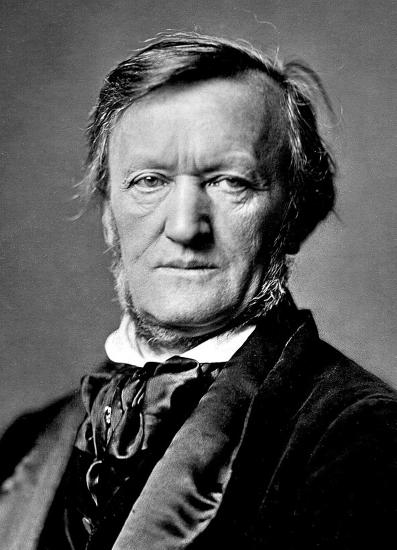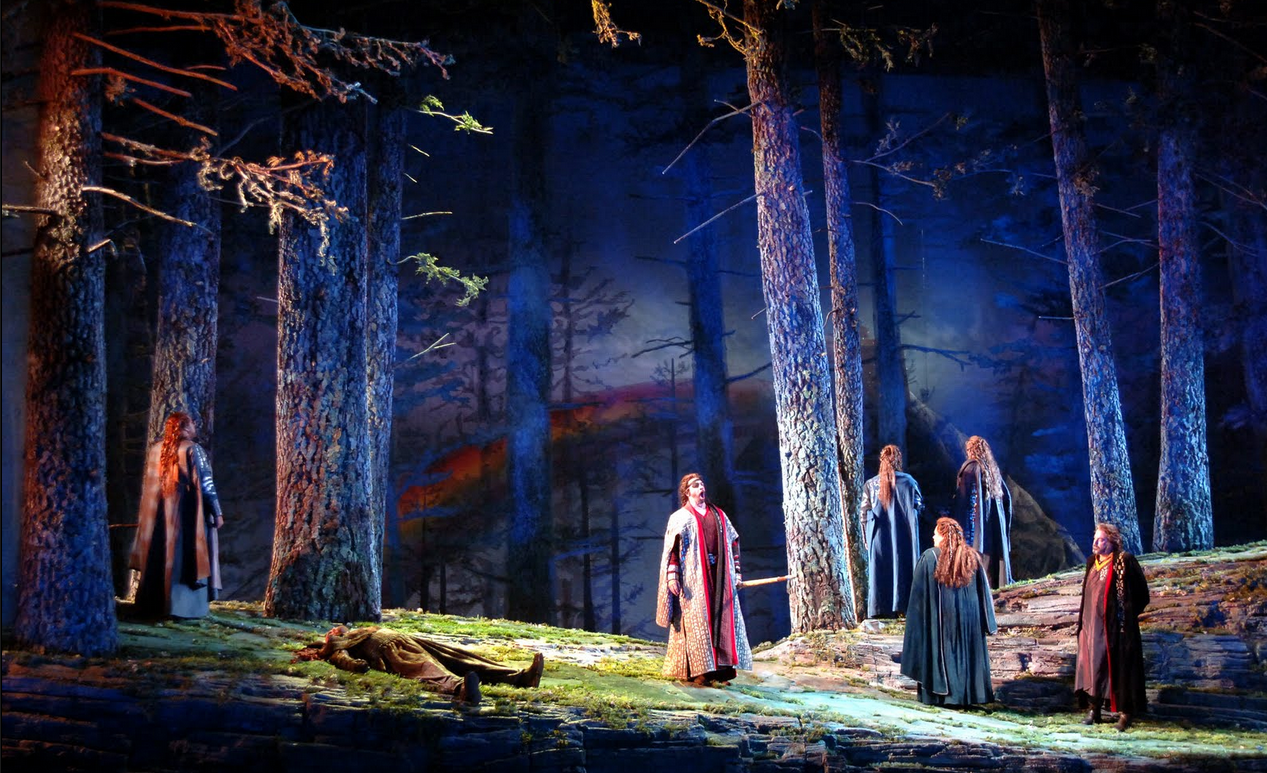12.4: Richard Wagner and the 19th Century Music Drama
- Page ID
- 165673
Richard Wagner and The Ring.
 Perhaps no other figure is as influential and polarizing as German-born composer Richard Wagner (1813-83). Known primarily as an opera composer, Wagner's musical influence is still felt today: his compositional approach to harmony and form greatly influenced the next generation of neo-Romantic composers. His theories on music and drama influenced early 20th century film music, which is still being felt today. Composers for movies and video games alike continue to employ much of the Wagner's compositional practices, mainly the use of "character themes" and other leitmotifs (more on that below).
Perhaps no other figure is as influential and polarizing as German-born composer Richard Wagner (1813-83). Known primarily as an opera composer, Wagner's musical influence is still felt today: his compositional approach to harmony and form greatly influenced the next generation of neo-Romantic composers. His theories on music and drama influenced early 20th century film music, which is still being felt today. Composers for movies and video games alike continue to employ much of the Wagner's compositional practices, mainly the use of "character themes" and other leitmotifs (more on that below).
Wagner was an apologetic German nationalist: unlike many other composers, he wrote his own libretti, which were often full of fantastical plots and scenes rooted in German folklore, German epics, and the supernatural (i.e. Gods, magic, mysticism). His works often glorified the German land and the German people. He took part in the political Revolutions of 1848, and exiled himself to Switzerland to avoid arrest. While in exile, he wrote many essays on his own theories of music and its link to drama. Many of his essays have severe anti-Semitic undertones, which is still the topic of polemics in today's academic circles.
Wagner shared German philosopher Friedrich Nietzsche's views that Western art had been debased since the era of the Greek Drama; he argued that music, poetry, and dance were harmonized beautifully in ancient Greek drama, and that these different types of art were deprived of their full expressive potential when they were divorced from one another.
In 1851, Wagner wrote a book-length essay titled Oper und Drama (Opera and Drama), which discussed the aesthetics of drama through music. These ideas led to the Music Drama, a unique type of opera that incorporates music and theater. In these music dramas, there are no separate musical numbers: no arias, recitatives, choruses, or duets. Instead, there is constant music: melodies bleed into each other, creating a sense of endless melody. With the exception of scene changes, the music does not stop at all! Moreover, the orchestra plays just as an important role as the singers—some would argue that the orchestra's music plays a more significant role, as there are some instances where no words are sung for over a minute at a time! Instead, music is played by the orchestra, and the singer/actors on stage move through their choreography.
One of Wagner's most influential creations in his music dramas is the leitmotif or "leading motive". Leitmotifs are associative musical themes or short ideas that symbolize a person, object, place, state of mind, etc. Although there had been associative themes in the prior centuries, the leitmotif is much more complex than simply playing a melody whenever a character comes on stage: a true Wagnerian leitmotif evolves with the drama, and interacts with it at the same time. Wagner's use of leitmotifs influenced Hollywood composers of the early 20th century like Max Steiner and Erich Korngold, as well as modern film composers like John Williams, James Horner, and Howard Shore. Many composers for video games also use leitmotifs like Nobuo Uematsu, Hitoshi Sakimoto, Koji Kondo, and Wil Roget II (more on these in the following chapters).
(above) Photograph of Wanger by Franz Hanfstaengl. Public Domain.
The Ring Cycle.

A live performance of Seattle Opera's Ring Cycle. Screenshot taken from the Wagnerian Website.
The Ring Cycle is an exemplary example of Wagner's theories on Music Dramas in action. His ideas of combining poetry, music, drama, visuals, dancing, staging, costumes, and everything you see above represents his idea of Gesamtkunstwerk: that is, the "operatic total work of art." All different arts coming together to create a single work. This, he believed, returned the artistic aesthetic back to the ancient Greek Drama. In modern days, Wagner's Ring Cycle is performed with spectacular staging, as you can see from above. Every year in Beyreuth, Germany, the "Ring Festival" performs all four operas back-to-back in 4 days. Good seats for each opera is around $400---after taxes, it would cost a single person about $2000 to see the entire festival!
The Ring Cycle consists of 4 3-hour operas that tell the mythical story of gods, trolls, and other supernatural beings. The first opera is titled Das Rhinegold, which tells the story of an evil troll named Alberich, who steals the Rhine Maidens' gold after denouncing love. He forges the gold into a ring that gives the bearer power: this ring becomes the focus of greed over the course of all four operas (though you may see resemblance to Tolkien's Fellowship of the Ring, there is actually very little similarity outside of the ring itself).
In this chapter, we'll look at the finale from the 2nd opera of the cycle, The Valkyrie. In this scene, Wotan (one of the many gods) puts one of his Valkyries to "endless slumber" because she disobeyed him. Though he doesn't want to (she's one of his favorites), he needs to make sure the rules are followed. As a final gesture of love, he puts a ring of fire around her to ensure that only the bravest of souls will be able to awaken her (which occurs in the 3rd opera, Siegfried).
In this scene, we hear six different leitmotifs, each representing a different element in the opera, interacting with one another. These leitmotifs represent Wotan's spear (his weapon), Loge (the god of fire), Fire, "Eternal Sleep," "Endless Slumber," Siegried's sword (foreshadowing the next opera), and Fate. It's very difficult to describe each of these leitmotifs in text; watch the video presentation, and you'll be able to hear each of these leitmotifs played on their own before viewing the opera's final scene, where you can hear all of these themes interact with each other and the unfolding drama.

